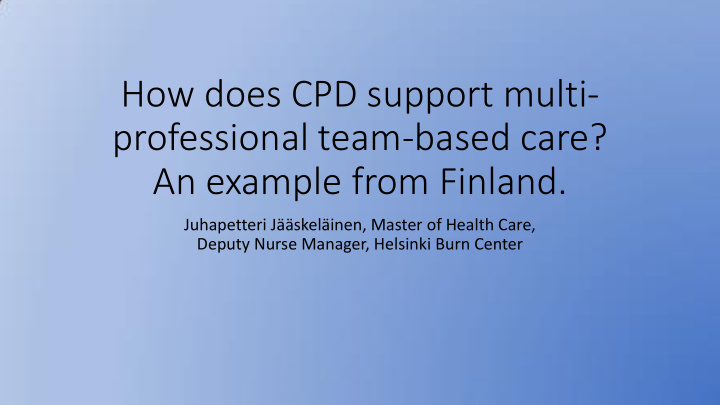



How does CPD support multi- professional team-based care? An example from Finland. Juhapetteri Jääskeläinen, Master of Health Care, Deputy Nurse Manager, Helsinki Burn Center
Basics for Trauma care • Trauma is a leading death cause in western countries for working age people • Finnish trauma patient is a middle aged man • Biggest reason for injury are traffic accidents • then falling and work related accidents • The most severe injuries are a result of traffic accidents • 80 % of deaths is caused by brain injury • Summer is the busiest time in trauma care
Object of care • Aim in traumacare – improve patient care quality • Reduce mortality • Mitigate injuries • Efficient use of resources
Problems in trauma care – starting point (2001) • Quality of treatment and available resources dependent on • Time of the day • Day of the week • Members of the team • No uniform practise • -> Not acceptable! Too many variables • AIM: • Provide high quality treatment for traumapatients 24 / 7 / 365
Solution • Traumaprotocol & traumateam • Improves quality of treatment • Reduces possibilities of conflicts • Quarantees that what needs to be done is done • Improves the spirit of the workplace Traumateam allows an horizontal approach – examinations and procedures can be carried out simultaneously
Traumaprotocol • Handbook for the traumateam • Instruction how to treat severely injured patient • Defines leadership and different roles in the team How is a team of professionals transformed into a professional team?
Traumateam members • Traumaleader – Orthopaedics and Traumatology doctor • Anaesthesiology doctor • Traumanurse • Anesthesia nurse • Surgical nurse • Radiology doctor • Radiographer x 2 • Medical Laboratory Technologist x 2 • Neurosurgeon if needed
& cervical spine control & environmental control Secondary survey – surgical procedures – imaging
Trauma resuscitation challenges
Continuing Professional Development in traumateam • Culture of the Töölö hospital • Has taken years to develope and work of several dedicated professionals • Individual training • Small-group teaching and discussions • Lectures – ward training days – trauma courses • Full scale simulations • Debriefing – traumameetings
Individual training • Ongoing individual orientation based on former experience • Can take from weeks to years • Learning at work • Personal mentoring – apprentice – mentor
Small-group teaching and discussions • Slow morning time is used to teach small-groups • Systematic evaluation of trauma patient and vital signs (A B C D E) • Monitors and equipment • Procedures • Non-technical skills • Communication • Multi-casualty incidents
Lectures – ward training days – trauma courses • Ward training days • Twice a year – two training days • Lectures • Small-group teaching • National conferences • Participants from different parts of Finland • Lectures and workshops • National trauma courses • For doctors and advanced doctors
Full scale simulations • Whole team practises in real-life conditions • Realistic mannekin
Debriefing - traumameetings • Debriefing after Trauma Team Activations • what we did right? • what could’ve been done better? • is there any concerns? • Traumameetings • Retrospective analysis of interesting patient-cases • Multi-ward, multiprofessional
• Technical skills – procedures etc are fairly easy to master • Non-technical-skills – organizing the team is difficult!
Non-techical skills & communication Task Teamwork management Communication Decision Situational making awareness
Conclusions • Training and learning matters • Technical and non-technical skills improve • Patient safety increses
Recommend
More recommend